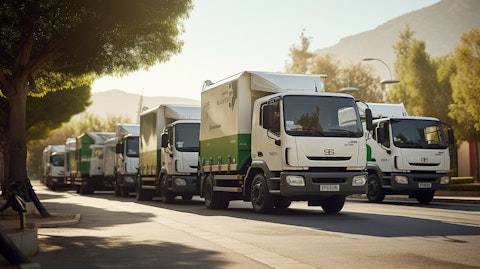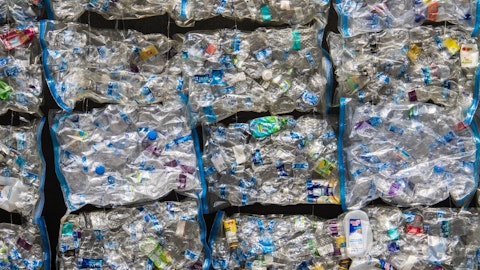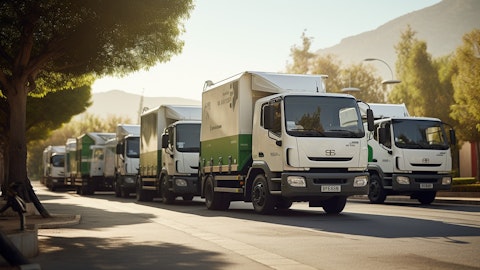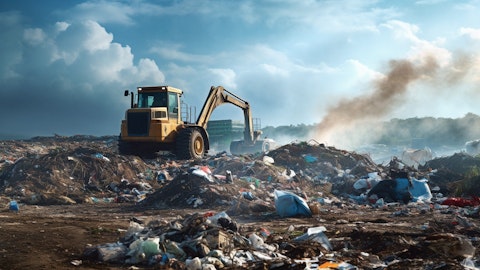Republic Services, Inc. (NYSE:RSG) Q1 2024 Earnings Call Transcript April 30, 2024
Republic Services, Inc. beats earnings expectations. Reported EPS is $1.45, expectations were $1.35. RSG isn’t one of the 30 most popular stocks among hedge funds at the end of the third quarter (see the details here).
Operator: Good afternoon, and welcome to the Republic Services First Quarter 2024 Investor Conference Call. Republic Services is traded on the New York Stock Exchange under the symbol, RSG. All participants in today’s call will be in listen-only mode. [Operator Instructions] After today’s presentation, there will be an opportunity to ask questions. [Operator Instructions] Please note this event is being recorded. I would now like to turn the conference over to Aaron Evans, Vice President of Investor Relations.
Aaron Evans: Thank you. I would like to welcome everyone to Republic Services first quarter 2024 conference call. Jon Vander Ark, our CEO; and Brian DelGhiaccio, our CFO, are on the call today as we discuss our performance. I would like to take a moment to remind everyone that some of the information we discuss on today’s call contains forward-looking statements, which involve risks and uncertainties and may be materially different from actual results. Our SEC filings discuss factors that could cause actual results to differ materially from expectations. The material that we discuss today is time sensitive. If in the future, you listen to a rebroadcast or recording of this conference call, you should be sensitive to the date of the original call, which is April 30th, 2024.
Please note that this call is property of Republic Services, Inc. Any redistribution, retransmission or rebroadcast of this call in any form without the express written consent of Republic Services is strictly prohibited. I want to point out that our SEC filings, our earnings press release, which includes GAAP reconciliation tables and a discussion of business activities, along with the recording of this call are available on Republic’s website, at republicservices.com. I want to remind you that Republic’s management team routinely participates in investor conferences. When events are scheduled, the dates, times and presentations are posted on our website. With that, I’d like to — I’d like to turn the call over to, Jon.
Jon Vander Ark: Thanks, Aaron. Good afternoon, everyone, and thank you for joining us. Our strong first quarter results demonstrate our focus on profitably growing the business. We produced revenue growth both organically and through acquisitions, while enhancing profitability across the enterprise. During the quarter, we achieved revenue growth of 8%, generated adjusted EBITDA growth of 12%, expanded adjusted EBITDA margin by 120 basis points, reported adjusted earnings per share of $1.45 and produced $535 million of adjusted free cash flow. The results we delivered are made possible by executing our strategy, supported by our differentiated capabilities. Regarding customers zeal, our efforts to provide best-in-class essential services and sustainability offerings continue to drive customer loyalty and organic growth in the business.
Our customer retention rate remained high at over 94%. And we continue to see favorable trends in our net promoter score as customers value our broad service offerings and the quality of our service delivery. Strong organic revenue growth during the first quarter was underpinned by core price on related revenue of 8.5% and average yield on related revenue of 7.3%. This level of pricing exceeded our internal cost inflation and resulted in over 100 basis points of EBITDA margin expansion. Organic volume on related revenue declined 1.1%. Large container and disposal volumes were negatively impacted by severe weather across most of our geographies during the first quarter. Most of the weather impact occurred in January, and we saw a notable rebound in volume performance in February and March as weather conditions normalized.
Turning to our digital capabilities. The team continues to advance the implementation of digital tools that improve the experience for both customers and our employees. Our RISE digital operations platform is driving improved route optimization and safety performance and providing more predictable service delivery to our customers. Development of our new asset management system is underway, which is expected to increase maintenance technician productivity and enhanced warranty recovery. We expect to begin deploying the new system later this year using a phased approach, which we estimate will result in $20 million of annual cost savings by 2026. We continue to benefit from advanced technology on recycling and waste collection routes. Our platform utilizes cameras to identify overfill containers and contamination and recycling containers.
This technology will reduce contamination in our recycling centers and is expected to generate approximately $60 million in incremental annual revenue. To-date, we have already achieved $30 million of annual benefit. Moving on to sustainability. We believe that our sustainability innovation investments in plastic circularity and renewable natural gas are a platform for profitable growth. Development of our polymer centers and Blue Polymers joint venture facilities remains on track. Our Las Vegas Polymer center is operational and delivery of plastic flake to our offtake partners began in March. Construction is progressing on our Indianapolis Polymer Center with equipment installation planned to begin in June. This operation will be co-located with a Blue Polymers production facility.

The renewable natural gas projects being co-developed with our partners continue to advance. One project came online during the first quarter, and we expect at least seven additional projects to be completed in 2024. We continue to advance our efforts to support decarbonization, including our industry-leading commitment to fleet electrification. We currently have 15 collection vehicles in operations. We expect to have more than 50 additional EVs to be added to our fleet in 2024. We now have seven facilities with commercial EV charging infrastructure. Development of 40 additional locations is underway with more than 10 new sites expected to be completed in 2024. As part of our approach to sustainability, we continually strive to be the employer of choice in the markets that we serve.
Employee turnover continues to improve with our first quarter turnover rate improving 70 basis points compared to the prior year. As a result, we are better staffed to optimize our operations and capitalize on growth opportunities in the market. Our comprehensive sustainability performance continues to be widely recognized as Republic Services was recently named to Barron’s 100 Most Sustainable Companies list, Ethisphere’s World’s Most Ethical Companies list and Fortune’s Most Innovative Companies List. With respect to capital allocation, we invested $41 million in acquisitions during the first quarter. Our acquisition pipeline remains supportive of continued activity in both the Recycling and Waste and Environmental Solutions businesses. We continue to see opportunity for $500 million of investment in value-creating acquisitions in 2024.
Additionally, we returned $168 million to shareholders through dividends in the first quarter. I will now turn the call over to Brian, who will provide details on the quarter.
Brian DelGhiaccio: Thanks, Jon. Core price on total revenue was 7%; core price on related revenue was 8.5%, which included open market pricing of 10.2% and restricted pricing of 5.7%. The components of core price on related revenue included small container of 12.2%, large container of 7.7% and residential of 8.1%. Average yield on total revenue was 6% and average yield on related revenue was 7.3%. First quarter volume on total revenue decreased 90 basis points and volume on related revenue decreased 1.1%. The components of our volume performance included a decrease in large container of 4.4%, primarily due to severe weather in January, along with continued softness in construction-related activity and a decrease in residential of 2.6%.
During the quarter, landfill MSW volume was up 1.6% and small container volume increased 30 basis points. Moving on to recycling. Commodity prices were $153 per ton during the first quarter. This compared to $105 per ton in the prior year. Recycling processing and commodity sales increased revenue by 40 basis points during the quarter. Commodity prices are exceeding our initial expectations as current commodity prices are approximately $160 per ton. Now, turning to our Environmental Solutions business. First quarter Environmental Solutions revenue increased $15 million compared to the prior year. The growth was due to the rollover impact from an acquisition that closed in the fourth quarter of 2023. Adjusted EBITDA margin in the Environmental Solutions business was 20.5%, which compared to 21% in the prior year.
After considering the dilutive impact from a recent acquisition of 110 basis points, EBITDA margin in the Environmental Solutions business increased 60 basis points. Total company adjusted EBITDA margin for the first quarter expanded 120 basis points to 30.2%, which was driven by margin expansion in the underlying business of 110 basis points. Other changes in margin performance during the quarter included a 20 basis point increase from recycled commodity prices and a 20 basis point increase from net fuel. This was partially offset by a 30 basis point decrease from acquisitions. Adjusted free cash flow was $535 million in the first quarter. Free cash flow conversion was 45.9%. Total debt was $13 billion and total liquidity was $2.8 billion.
Our leverage ratio at the end of the quarter was approximately 2.8 times. With respect to taxes, our combined tax rate and impact from equity investments and renewable energy resulted in an equivalent tax impact of 25.4% during the quarter, which was in line with our expectations. We also received a $12 million state grant associated with renewable energy investment. This benefit was recorded in other income and added $0.03 of EPS. This did not impact EBITDA or EBITDA margin during the quarter. With that, operator, I would like to open the call to questions.
See also 15 Best Places to Retire in Kansas and 12 Best Alternatives to Adidas Samba.
Q&A Session
Follow Republic Services Inc. (NYSE:RSG)
Follow Republic Services Inc. (NYSE:RSG)
Receive real-time insider trading and news alerts
Operator: We will now begin the question-and-answer session. [Operator Instructions] Your first question comes from Jerry Revich with Goldman Sachs. Please go ahead.
Unidentified Analyst: Hi. This is Adam on for Jerry today. Thanks for taking our question. So your first polymer center recently opened. Just wondering how that plan is tracking versus your initial expectations? Any surprises there?
Jon Vander Ark: No. It probably opened a month later than we thought all around related permitting and infrastructure issues. The core operations are actually exceeding our expectation. Shipping to customers, they think it is some of the, if not the, cleanest recycled PET flake in the world. So the facilities, the team are executing really, really well. And again happy with our equipment providers, happy with everything, and we’re up and running in Indianapolis, and we’re probably should shortly announce our third location on the East Coast.
Unidentified Analyst: Terrific. And then shifting to US Ecology. Just wondering, if you can update us on how you’re thinking about what level of margin upside is feasible for that business once you fully integrated the systems just based on your experience on optimizing route profitability and pricing for your base business? What’s the level of margin upside potential there?
Jon Vander Ark: Yes. We’re targeting a 25% EBITDA margin there in the midterm and it’s really going to be a series of levers, right? We’re going to think about customer mix and making sure that we have customers that are willing to pay. We’ll obviously think about pricing for the value we deliver on that. We’ll drive additional revenue through cross-sell, which we’ve talked about. And the IT investments help there, they also help us manage the middle, just better labor utilization, more efficiency in terms of disposal — optimizing disposal assets and getting the material into the right spot. And then as we grow, we’ll certainly get more leverage on our SG&A. So we’ve got a series of levers that we think get us to 25% in the midterm.
Unidentified Analyst: Great. Thanks so much.
Operator: Thank you. The next question is from Toni Kaplan with Morgan Stanley. Please proceed with your question.
Toni Kaplan: Thanks so much. You mentioned the weakness in volume related to weather. I was hoping that you could give the weather impact in the quarter?
Brian DelGhiaccio: We think, overall, that was about a 50 basis point drag on total volume performance. So you can think about that being down circa 1%, half of which was weather-related and then just half more in those cyclical volumes as we talked about construction activity and the like.
Toni Kaplan: Yes. Okay. That makes a lot of sense. And then just wanted to ask about pricing, strong core price again this quarter, maybe a little bit above expectation. I think you mentioned it exceeded your expectation as well. I think last quarter, you talked about trajectory of 1Q being the high point, 4Q likely being the low end. Is that still your expectation? And has anything in the inflationary backdrop changed your view on how price plays out or how good price was in the first quarter? Thanks.
Jon Vander Ark: Yes, I think it’s modestly exceeded our expectations. And I think that cadence we laid out is still right as we see the — it will sort of come down. Could we extend that a little higher? Is the interest rates remain high and I think inflation has been a little stickier than people expected? Yes, I think there’s certainly potential for that.
Toni Kaplan: Terrific. Thanks.
Operator: Thank you. The next question is from Michael Hoffman with Stifel. Please go ahead.
Michael Hoffman: Hi. Good afternoon. Thanks for taking my questions. So I guess one on ES would be the cross-sell. When you bought it, you didn’t expect — you didn’t put that into the plan, but — it’s been proving to be a positive contributor. How do we track against where you — we are now in that cross-sell? What’s that incremental total dollar we picked up?
Jon Vander Ark: Yes. I think we’re making great progress on that, Michael. Listen, that ES was a little softer in the quarter or certainly weather impacted them, and they were also coming off a pretty tough comp, because we had a great first quarter last year. But that pipeline remains strong. I think we stopped talking about the pipeline at $150 million. That pipeline has grown from there. Now that pipeline is over a couple of years. It builds out as these opportunities develop. Either the work initiated from a recurring generator or sometimes, it’s a project that has a scheduled start that has pushed out a few months. So we feel really good about that. And frankly, there’s another wave of upside as we get integrated on the IT side.
And then we get our sales organization kind of optimized against those customer lists and that information. We think there’s strong pull-through. I think what’s been undeniable for us is that customers want and desire a single-source solution. And this integrated offering is something that we could sell very profitably in the marketplace.
Michael Hoffman: Okay. And then switching gears back to the solid waste business. So that opportunity to capture surcharges and overages through the digital platform, what’s the point of conversion of that into a permanent revenue. So you got the — eventually salesperson shows up and says, “Hey, your container is always overflowing and you convert it into a permitted upgrade. What’s that look like? How do we think about that?”
Brian DelGhiaccio: Yes. Michael, to your point, the obvious solution to that is to sit there and either get an increased level of service, whether it be the size of the container or just a number of times the frequency that we’re providing that service. But when you take a look just at those incremental revenues, they’ve been fairly sticky, meaning, even though we’ve had these because they’re not consistent, they tend to be somewhat episodic as well. So again, when we’re providing the service based on a certain amount of volume within that container, if there’s those overages we’re going to charge for that and same with the contamination. Ultimately, could that change behavior overtime? Yes, and we would want that. And at which point then that probably just results in increased frequency, which positively impacts the top line as well.





